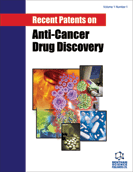
Abstract
The Ras/Raf/MEK/ERK mitogen-activated protein kinase (MAPK) pathway mediates cellular responses to different growth signals and is frequently deregulated in cancer. There are three Raf kinases-A-Raf, B-Raf, and C-Raf; however, only B-Raf is frequently mutated in various cancers. The most common B-Raf mutation involves a substitution of a glutamic acid residue to a valine moiety at codon 600. Subsequently, the MAPK pathway is constitutively activated, even in the absence of any growth signals. Although early attempts to target Ras have not yielded any viable drug candidates, many novel compounds inhibiting the activities of Raf and MEK have been developed and investigated in clinical trials in recent years. The first MEK inhibitor (CI-1040) lacked efficacy in clinical trials, but its low toxicity has encouraged the search for novel compounds with enhanced target potency to inhibit MAPK activation at low nanomolar concentrations. In this review, we will discuss new patents or patent applications related to inhibitors of the Ras/Raf/MEK/ERK pathway.
Keywords: B-Raf, MEK, ERK, MAPK, imidazole derivatives, heterocyclic compounds
Recent Patents on Anti-Cancer Drug Discovery
Title: Recent Developments in Anti-Cancer Agents Targeting the Ras/Raf/ MEK/ERK Pathway
Volume: 4 Issue: 1
Author(s): Kwong-Kwok Wong
Affiliation:
Keywords: B-Raf, MEK, ERK, MAPK, imidazole derivatives, heterocyclic compounds
Abstract: The Ras/Raf/MEK/ERK mitogen-activated protein kinase (MAPK) pathway mediates cellular responses to different growth signals and is frequently deregulated in cancer. There are three Raf kinases-A-Raf, B-Raf, and C-Raf; however, only B-Raf is frequently mutated in various cancers. The most common B-Raf mutation involves a substitution of a glutamic acid residue to a valine moiety at codon 600. Subsequently, the MAPK pathway is constitutively activated, even in the absence of any growth signals. Although early attempts to target Ras have not yielded any viable drug candidates, many novel compounds inhibiting the activities of Raf and MEK have been developed and investigated in clinical trials in recent years. The first MEK inhibitor (CI-1040) lacked efficacy in clinical trials, but its low toxicity has encouraged the search for novel compounds with enhanced target potency to inhibit MAPK activation at low nanomolar concentrations. In this review, we will discuss new patents or patent applications related to inhibitors of the Ras/Raf/MEK/ERK pathway.
Export Options
About this article
Cite this article as:
Wong Kwong-Kwok, Recent Developments in Anti-Cancer Agents Targeting the Ras/Raf/ MEK/ERK Pathway, Recent Patents on Anti-Cancer Drug Discovery 2009; 4 (1) . https://dx.doi.org/10.2174/157489209787002461
| DOI https://dx.doi.org/10.2174/157489209787002461 |
Print ISSN 1574-8928 |
| Publisher Name Bentham Science Publisher |
Online ISSN 2212-3970 |
 95
95
- Author Guidelines
- Graphical Abstracts
- Fabricating and Stating False Information
- Research Misconduct
- Post Publication Discussions and Corrections
- Publishing Ethics and Rectitude
- Increase Visibility of Your Article
- Archiving Policies
- Peer Review Workflow
- Order Your Article Before Print
- Promote Your Article
- Manuscript Transfer Facility
- Editorial Policies
- Allegations from Whistleblowers
Related Articles
-
Diffuse Intrinsic Pontine Glioma (DIPG): Breakthrough and Clinical Perspective
Current Medicinal Chemistry Cancer Stem Cells: How can we Target them?
Current Medicinal Chemistry Patent Selections:
Current Biomarkers (Discontinued) Rock1 & 2 Perform Overlapping and Unique Roles in Angiogenesis and Angiosarcoma Tumor Progression
Current Molecular Medicine Fusing Multiple Biological Networks to Effectively Predict miRNA-disease Associations
Current Bioinformatics Biological Activities, Mechanisms of Action and Biomedical Prospect of the Antitumor Ether Phospholipid ET-18-OCH3 (Edelfosine), A Proapoptotic Agent in Tumor Cells
Current Drug Metabolism Determination of Dysregulated miRNA Expression Levels by qRT-PCR after the Application of Usnic Acid to Breast Cancer
Anti-Cancer Agents in Medicinal Chemistry The Past, Current Studies and Future of Organometallic <sup>99m</sup>Tc(CO)3 Labeled Peptides and Proteins
Current Pharmaceutical Design Meet the Editorial Board:
Current Alzheimer Research Intraperitoneal Oncolytic and Tumor Vaccination Therapy with Replication-Competent Recombinant Virus: The Herpes Paradigm
Current Gene Therapy Recent Advances in Application of Poly-Epsilon-Caprolactone and its Derivative Copolymers for Controlled Release of Anti-Tumor Drugs
Current Cancer Drug Targets Potential Involvement of Extracellular Citrate in Brain Tumor Progression
Current Molecular Medicine PI3K Inhibitors for Cancer Therapy: What has been Achieved So Far?
Current Medicinal Chemistry Mitosis-Targeting Natural Products for Cancer Prevention and Therapy
Current Drug Targets Vasculogenic and Angiogenic Pathways in Moyamoya Disease
Current Medicinal Chemistry Predictive Efficacy Biomarkers of Programmed Cell Death 1/Programmed Cell Death 1 Ligand Blockade Therapy
Recent Patents on Anti-Cancer Drug Discovery Novel Synthetic Lethality Approaches for Drug Combinations and Early Drug Development
Current Cancer Drug Targets Neuropathic Pain and Lung Delivery of Nanoparticulate Drugs: An Emerging Novel Therapeutic Strategy
CNS & Neurological Disorders - Drug Targets Cannabis-Derived Substances in Cancer Therapy – An Emerging Anti- Inflammatory Role for the Cannabinoids
Current Clinical Pharmacology Transporters at CNS Barrier Sites: Obstacles or Opportunities for Drug Delivery?
Current Pharmaceutical Design


























